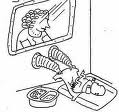 Love them or hate them, nappies will be a big part of your life over the next couple of years and an area of discussion with your friends on many occasion!
Love them or hate them, nappies will be a big part of your life over the next couple of years and an area of discussion with your friends on many occasion!
It’s a pretty awful job, but one that you’ll soon become used to and find second nature!
With so many types of nappies to choose from, it’s hard to know which is best. Check out our nappy review section to help you decide on which nappy to use for your baby!
Once you’ve decide which type of nappy to use, you’ve got the task of handling those messy little accidents that come as part and parcel of parenthood!
How to change a nappy!
Before you begin, gather a few supplies. Make sure you have everything you are likely to need within reach:
•A nappy
•A changing mat on the floor, or a cloth nappy to place under your baby or a changing station or table.
•Fasteners (if you are using reusable nappies)
•A container of warm water and cotton balls (for newborns or babies with sensitive skin) or baby wipes (for older babies or those who aren’t sensitive to wipes)
•Nappy rash cream or petroleum jelly (if needed for rashes)
Before beginning think safety first! Babies should never be left unattended, not even for a second. Even a newborn might surprise you with his ability to roll!
Changing your baby
•Either undo the poppers on your baby’s sleep suit or vest, or remove the clothes on the lower half of your baby’s body. Put out of the way and not likely to get wet or dirty.
•Undo the nappy and use the nappy to clean off anything remaining on his skin.
•Remove the nappy, folding it over as you do so, and place it out of reach of your baby. You may wish to have a nappy bag open and ready to pop it in immediately (if disposable) or you may wish to leave it open near by (out of babys’ reach) so you can put the dirty wipes/cotton wool inside it.
•Wipe your baby’s skin using either cotton wool and water or a baby wipe from the front to the back (never wipe from back to front, especially on girls, or you could spread the bacteria that can cause urinary tract infections forward from the rectum). Don’t forget the creases in the thighs and bottom.
•Hold your baby’s ankles together and lift his legs so that you can slide a clean nappy underneath his or her bottom.
If you are using disposable nappies the back part with the adhesive strips should be about level with your baby’s tummy button. Bring the adhesive strips around and fasten snugly. Be careful not to stick the tape onto your baby’s skin.
If your’e using a reusable nappy, put the a liner into the nappy first.
•Do up the nappy and secure with tabs (or pins/poopers if reusable)
•Do up your baby’s clothes.
Nappy notes!
•If you find any marks around your baby’s legs and waist, the nappy is too tight. Go for a looser fit next time, and don’t pull it so tight.
•If a rash develops at the nappy’s openings around your baby’s leg and waist you may not be changing your baby enough or he may have an allergy to the brand of nappy you are using.
•When putting a nappy on a boy, place the penis in a downward position before fastening the nappy. This will help prevent leaks from creeping up above the waistline, especially useful at night time.
•Fold down the waistline of the nappy if your baby’s umbilical cord has not fallen off yet to keep that area dry.
•Always wash your hands well after changing your baby’s nappy to prevent the spread of germs.






Recent comments